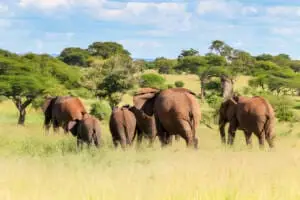Introduction to the Umbwe Route
Umbwe Route welcome to the ultimate journey to the roof of Africa! In this article, we will delve into the beauty and challenges of the Umbwe Route, one of the most exhilarating and lesser-known routes to reach the summit of Mount Kilimanjaro. If you are an adventure seeker and are looking for an unforgettable experience, the Umbwe Route is the perfect choice. This route offers a unique and awe-inspiring perspective of the mountain, allowing you to immerse yourself in its natural beauty and witness the wonders of the African wilderness.
Why choose the Umbwe Route?
The Umbwe Route is known for its rugged and steep terrain, making it a challenging but rewarding option for experienced hikers. Unlike the more popular routes, such as the Machame or Marangu, the Umbwe Route offers a sense of seclusion and solitude, allowing you to truly connect with nature and escape the crowds. The route is less frequented, providing a sense of exclusivity and tranquility that is rare to find on the mountain.
Furthermore, the Umbwe Route offers stunning panoramic views of the surrounding landscapes, including the lush rainforest, the dramatic Barranco Wall, and the majestic glaciers of Mount Kilimanjaro. The route also boasts a diverse range of flora and fauna, with the opportunity to spot unique wildlife such as colobus monkeys, eagles, and various species of birds. If you are seeking a true adventure and are up for the challenge, the Umbwe Route will not disappoint.
Physical preparation for the Umbwe Route
Preparing your body for the physical demands of the Umbwe Route is crucial to ensure a successful and enjoyable experience. The route is known for its steep ascents and descents, requiring a high level of cardiovascular fitness and endurance. Incorporating regular cardiovascular exercises such as running, hiking, or cycling into your training routine will help build stamina and improve your overall fitness level.
Additionally, strength training exercises that target your lower body muscles, such as squats, lunges, and calf raises, will help build the necessary strength and stability for the challenging terrain. It is also important to gradually increase the intensity and duration of your training sessions to mimic the demands of the actual hike. Remember to listen to your body and take rest days to allow for recovery and prevent overexertion.
Mental preparation for the Umbwe Route
While physical preparation is essential, mental preparation is equally important when undertaking the Umbwe Route. The hike can be mentally challenging, especially during the strenuous ascent to the summit. It is crucial to cultivate a positive mindset, resilience, and determination to overcome any obstacles that may arise during the journey.
Visualizing yourself reaching the summit and achieving your goal can be a powerful tool in staying motivated and focused. Practicing mindfulness and meditation techniques can help calm the mind, reduce anxiety, and increase mental clarity. Surrounding yourself with a supportive and like-minded group of fellow hikers can also provide encouragement and motivation throughout the journey.

Equipment and packing list for the Umbwe Route
Proper equipment and packing are essential for a successful and comfortable hike on the Umbwe Route. Here is a comprehensive list of items you should consider bringing:
Hiking boots: Invest in a good pair of hiking boots that provide ankle support and are comfortable for long hours of walking.
Backpack: Choose a backpack with a capacity of at least 50 liters to carry your essentials.
Sleeping bag: Opt for a sleeping bag suitable for cold temperatures, as the nights on the mountain can be freezing.
Clothing layers: Pack a variety of lightweight and moisture-wicking clothing layers to adapt to changing weather conditions.
Rain gear: Be prepared for rain by bringing a waterproof jacket and pants.
Headlamp: A headlamp is essential for early morning starts and navigating in the dark.
Water purification tablets: Ensure access to clean drinking water by carrying water purification tablets.
First aid kit: Pack a basic first aid kit with essential items such as bandages, pain relievers, and blister treatment.
Snacks and hydration: Bring high-energy snacks and a hydration system or water bottles to stay nourished and hydrated throughout the hike.
Camera and binoculars: Capture the breathtaking views and wildlife encounters with a camera and binoculars.
Remember to pack light and prioritize essential items. It is also important to check with your tour operator for any additional equipment or gear recommendations specific to the Umbwe Route.
Day-by-day itinerary of the Umbwe Route
Day 1:
Arrival in Moshi Upon arrival in Moshi, you will be transferred to your accommodation for a pre-hike briefing and equipment check. Take this opportunity to rest and acclimatize to the local time.
Day 2:
Umbwe Gate to Umbwe Camp The hike begins at the Umbwe Gate, where you will register with the park authorities and start your ascent through the dense rainforest. The trail can be steep and challenging, but the lush vegetation and occasional wildlife sightings make for an enchanting experience. Reach Umbwe Camp at an altitude of approximately 2,850 meters.
Day 3:
Umbwe Camp to Barranco Camp Continue your ascent through the moorland, gradually gaining altitude. The trail offers stunning views of the surrounding landscapes and the iconic Barranco Wall. Arrive at Barranco Camp, situated at an altitude of around 3,950 meters. Take the opportunity to rest and acclimatize.
Day 4:
Barranco Camp to Karanga Camp Embark on a challenging day of hiking, navigating the Barranco Wall and traversing through alpine desert terrain. The panoramic views and unique rock formations make this section of the hike particularly memorable. Reach Karanga Camp at an altitude of approximately 3,995 meters.
Day 5:
Karanga Camp to Barafu Camp Continue your ascent through the alpine desert towards Barafu Camp, situated at an altitude of approximately 4,650 meters. This section of the hike is physically demanding, with steep ascents and thin air. Take the opportunity to rest and prepare for the final push to the summit.
Day 6:
Barafu Camp to Uhuru Peak to Mweka Camp Begin the summit attempt in the early hours of the morning, aiming to reach Uhuru Peak, the highest point on Mount Kilimanjaro. The ascent is challenging and requires mental and physical endurance. Celebrate your achievement at the summit before descending to Mweka Camp for a well-deserved rest.
Day 7:
Mweka Camp to Mweka Gate Complete your descent through the rainforest, enjoying the lush scenery and reflecting on your incredible journey. Arrive at Mweka Gate, where you will receive your well-deserved certificate of achievement. Transfer back to your accommodation in Moshi to celebrate your accomplishment.
Highlights and challenges of the Umbwe Route
The Umbwe Route offers a multitude of highlights and challenges that make it a truly unique and rewarding experience. One of the main highlights is the sense of seclusion and intimacy with nature that the route provides. Unlike the more popular routes, the Umbwe Route offers a quieter and more solitary experience, allowing you to fully immerse yourself in the beauty of the surroundings.
The diverse landscapes encountered along the route are another highlight. From the lush rainforest to the barren alpine desert, each day brings forth a new and breathtaking scenery. The panoramic views from the various campsites and viewpoints are simply awe-inspiring, showcasing the natural beauty of Mount Kilimanjaro and its surroundings.
However, it is important to note that the Umbwe Route is not for the faint-hearted. The steep and challenging terrain, especially during the summit attempt, requires a high level of physical fitness and mental resilience. The altitude can also pose a challenge, with the risk of altitude sickness. It is crucial to acclimatize properly and listen to your body throughout the journey.
Safety tips for hiking the Umbwe Route
Hiking the Umbwe Route requires careful planning and preparation to ensure a safe and enjoyable experience. Here are some safety tips to keep in mind:
Choose a reputable tour operator:
Select a tour operator with a proven track record and experienced guides who prioritize safety.
Acclimatize properly:
Take your time to acclimatize at each campsite and follow the recommended altitude gain guidelines.
Stay hydrated:
Drink plenty of water throughout the hike to prevent dehydration. Avoid consuming alcohol and caffeine, as they can contribute to dehydration.
Listen to your body:
Pay attention to any signs of altitude sickness, such as headache, nausea, or dizziness. If symptoms persist or worsen, descend immediately and seek medical attention.
Follow the lead of your guide:
Your guide is experienced and knowledgeable about the route. Listen to their instructions and advice.
Dress appropriately:
Layer your clothing to adapt to changing weather conditions. Protect yourself from the sun with sunscreen and wear a hat and sunglasses.
Use trekking poles:
Trekking poles can provide stability and reduce strain on your joints, especially during steep descents.
Eat a balanced diet:
Maintain your energy levels by consuming a balanced diet that includes carbohydrates, proteins, and healthy fats.
Communicate with your group:
Stay connected with your fellow hikers and communicate any concerns or difficulties you may have.
Respect the environment:
Follow Leave No Trace principles and minimize your impact on the environment. Respect the local culture and wildlife.
By following these safety tips and staying vigilant throughout your journey, you can ensure a safe and memorable experience on the Umbwe Route.
Accommodation and camping options on the Umbwe Route
Accommodation on the Umbwe Route consists of camping at designated campsites along the trail. These campsites provide basic facilities such as toilets and water sources, allowing you to rest and recharge after a day of hiking.
Umbwe Camp, situated at an altitude of approximately 2,850 meters, is the first campsite on the route. It offers stunning views of the surrounding rainforest and provides a peaceful atmosphere for a good night’s rest.
Barranco Camp, located at an altitude of around 3,950 meters, is the second campsite on the Umbwe Route. It is nestled in a valley and offers breathtaking views of the towering Barranco Wall. The campsite is renowned for its scenic beauty and is a popular spot for trekkers.
Karanga Camp, situated at an altitude of approximately 3,995 meters, is the third campsite on the route. It offers panoramic views of the surrounding landscapes and is a crucial acclimatization point before the final push to the summit.
Barafu Camp, located at an altitude of approximately 4,650 meters, is the final campsite before the summit attempt. It is a challenging campsite due to its high altitude and barren terrain. However, it provides a strategic starting point for the summit push and offers stunning views of the glaciers.
Mweka Camp, situated at an altitude of around 3,100 meters, is the final campsite on the descent. It is located in the lush rainforest, providing a refreshing and serene environment after the challenging summit attempt.
Wildlife and natural beauty on the Umbwe Route
The Umbwe Route is renowned for its abundant wildlife and natural beauty. As you hike through the rainforest section of the route, keep an eye out for colobus monkeys swinging through the trees and various species of birds fluttering about. The lush vegetation and vibrant flowers create a picturesque backdrop, adding to the overall beauty of the surroundings.
As you ascend higher, you will enter the alpine desert zone, characterized by barren landscapes and unique rock formations. The stark contrast between the lush rainforest and the arid desert creates a captivating visual experience. Take the time to appreciate the rugged beauty of the terrain and the vastness of the landscapes stretching before you.
Additionally, the Umbwe Route offers stunning views of the glaciers on Mount Kilimanjaro. These majestic ice formations are a sight to behold and provide a stark reminder of the impact of climate change. Witnessing the glaciers up close is a humbling experience and serves as a powerful motivation to protect and preserve our natural environment.
Tips for a successful summit on the Umbwe Route
Reaching the summit of Mount Kilimanjaro is a challenging but immensely rewarding experience. Here are some tips to increase your chances of a successful summit on the Umbwe Route:
Acclimatize properly:
Take your time to acclimatize at each campsite and follow the recommended altitude gain guidelines. This will help your body adjust to the thin air and minimize the risk of altitude sickness.
Stay hydrated and nourished:
Drink plenty of water and consume high-energy snacks throughout the hike to maintain your energy levels. Proper hydration and nutrition are crucial for a successful summit attempt.
Pace yourself:
Take the hike at a steady and sustainable pace. Avoid rushing or pushing yourself too hard, as this can lead to exhaustion and increase the risk of altitude sickness.
Dress appropriately:
Layer your clothing to adapt to changing weather conditions. Ensure you have warm and waterproof clothing for the summit attempt, as temperatures can drop significantly.
Use trekking poles:
Trekking poles can provide stability and reduce the strain on your legs and joints during steep ascents and descents. They can also help conserve energy and improve your overall balance.
Focus on your breathing:
During the summit attempt, focus on deep and steady breathing to maximize oxygen intake and minimize fatigue. Take regular breaks to catch your breath and rest if needed.
Stay positive and motivated:
Maintain a positive mindset and keep your goal of reaching the summit in mind. Surround yourself with supportive and like-minded individuals who can provide encouragement and motivation.
Follow your guide’s instructions:
Your guide is experienced and knowledgeable about the route. Listen to their instructions and advice, as they will guide you safely to the summit.
Celebrate your achievements:
Take the time to celebrate your achievements at each milestone and enjoy the journey. The summit is the ultimate goal, but the entire experience is what truly matters.
Conclusion: The unforgettable experience of the Umbwe Route
Embarking on the Umbwe Route is not for the faint-hearted, but it offers an unforgettable adventure for those seeking a unique and challenging experience. From the lush rainforest to the barren alpine desert,









